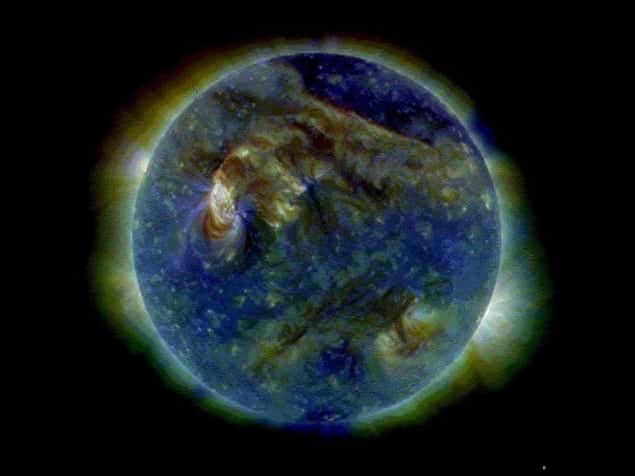
New findings from NASA’s Solar Dynamics Observatory (SDO) reveal that the Sun’s surface is an even more complicated web of physical and magnetic processes than previously thought. The finding was unveiled this week in San Francisco at the American Geophysical Union (AGU) Fall Meeting and could lead to better forecasts of radiation levels experienced by satellites.
The surface of the Sun is an incredibly volatile environment, which frequently ejects intense radiation and clouds of energetic radiation into space. These emissions pose a serious threat to astronauts and if they reach Earth they can wreak havoc with telecommunications satellites.
The research focuses on the analysis of an event that occurred on 1 August 2010 when almost the entire Earth-facing side of the Sun erupted in a tumult of activity, including solar flares and coronal mass ejections (CMEs). The event was captured by equipment on board the SDO, launched in February to investigate the causes of solar variability and how this creates a weather system in space.
Connected phenomena
While earlier missions have returned data from isolated active regions of the Sun, the SDO and its twin STEREO spacecraft were specifically designed to study magnetic activity over almost the whole star. This enabled Karel Schrijver and Alan Title of Lockheed Martin’s Solar and Astrophysics Laboratory to deconstruct the activities of 1 August to look for connections between the different phenomena.
We can see that solar storms can be global events, playing out on scales we scarcely imagined before Karel Schrijver, Lockhead Martin
The breakthrough came when the researchers discovered that bursts of solar activity appear to be connected via a system of magnetic fault zones known as “separatrices”. In a paper due to be published in the Journal of Geophysical Research, Schriver and Title break down the activity into 12 significant events over a 28-hour period spanning 180 degrees of solar longitude. “The 1 August event really opened our eyes,” says Schrijver. “We can see that solar storms can be global events, playing out on scales we scarcely imagined before.”
The researchers admit, however, that much work remains in order to unravel the causes and effects in these dynamic processes, and for this they will need to study more events. “Nor all eruptions are going to be global,” notes Title. “But the global character of solar activity can no longer be ignored.”
A more comprehensive understanding of solar processes could also lead to more accurate forecasts of space weather conditions, a development welcomed by Rodney Viereck of the US’s National Oceanic and Atmospheric Administration. “Solar flares can be particularly hazardous as they disturb high-frequency radio communications and GPS and the disruptions occur very quickly as the dangerous X-rays travel at the speed of light”.



